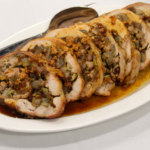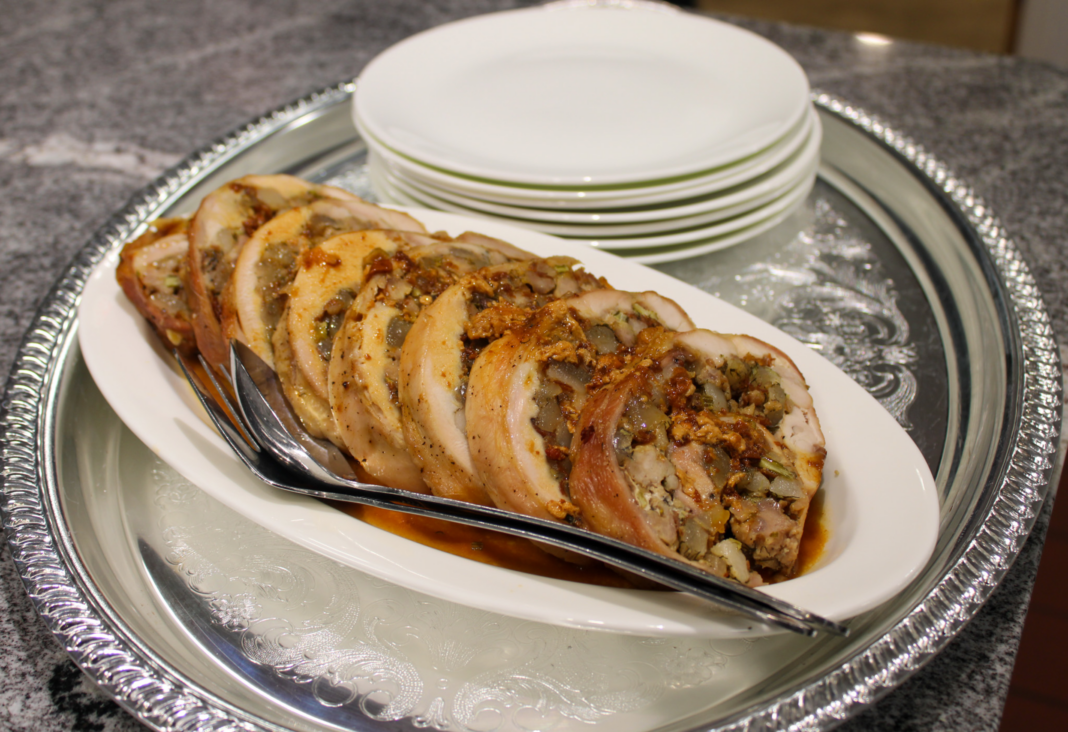A lesson in sustainability from traditional European cuisine.
I have been thinking a lot about rabbit meat in the last four months. As a former vegan and as someone whose environmental stewardship values are often reflected on my plate, cooking and consuming animal protein is something I do only with intention. But, this past fall, when I participated in Boston University’s Certificate Program in the Culinary Arts, I intended to eat, cook, and learn as much as possible. And, in the mainstream gastronomical world, meat is very much on the menu. Which brings me back to rabbit meat.
At Taberna de Haro, a Spanish restaurant and wine bar in Brookline, rabbit has been a mainstay on the menu since it opened in 1998. When the chef-owner Deborah Hansen visited our BU class, we learned to butcher and braise rabbit in a traditional Spanish way. Chef Hansen, who is passionate about local and sustainable foods, bemoaned the lack of commercial acceptance that rabbit meat has had in the U.S. Farmed rabbit, she said, was far more sustainable than beef but harder to come by in the states versus the ease with which she could acquire it in Spain. This got me thinking about whether rabbit could be a food of the future.

A month later, I started to prepare for The Rebecca Alissid Award in Culinary Arts sponsored by The Mary Ann Esposito Foundation, an Italian cooking legend, and rabbit meat hopped in the picture again. To be considered for the award I needed to plan and execute a four-course meal from one region in Italy highlighting the local food and products from that region. I was brainstorming with my Italian friend, Nico, who hails from the region I planned to highlight, Le Marche.
“Caro, you need to cook the rabbit,” he told me over espresso one afternoon as we looked through Italian cookbooks. I thought back to Chef Hansen’s words about how Americans should eat more rabbit meat because it’s sustainable. The rabbit, Nico told me, was what a Le Marche family would make when someone brought home a new partner for the first time. Being asked, “Have you had the rabbit?” really meant “So, is it getting serious?” For the dish, the rabbit was deboned and rolled up like a jelly roll but instead of jelly it was stuffed with pork skin, ground meat, and wild fennel. Coniglio in porchetta is not only a delicious dish but a special one, too. And, hearing about Coniglio in porchetta is how I thought about cooking rabbit for the second time in a month.
Because I am a curious person, and because I am always looking for ways to mitigate and adapt to climate change using my grocery list, I dove deeper into the environmental impact of eating rabbit. And, like all things having to do with food resources and the climate, it’s complicated.
This status of rabbit as a functional food can (and should) play into how it’s viewed in the realm of sustainability. If something is really good for us, shouldn't we make room in our carbon budget for it?
As a food source, rabbit is very nutritious and has a high protein content, low-fat content, a high percentage of unsaturated fatty acids, low cholesterol, and sodium levels. For this reason, it’s considered a “functional food.” A functional food, coined in Japan in the 1980s, is a food that goes beyond offering simple nutritional value and offers life-giving bodily support. The regular consumption of rabbit meat provides consumers with bioactive compounds necessary for controlling chronic diseases. This status of rabbit as a functional food can (and should) play into how it’s viewed in the realm of sustainability. If something is really good for us, shouldn't we make room in our carbon budget for it?
Rabbit farming could support rural areas via the creation of economic activities and counteract the process of the abandonment of rural areas. It’s hard to imagine what large-scale regenerative rabbit farming might look like because we haven't considered it yet. But, the land revitalization and economic sustainability due to rabbit farming both have potential. Both the highly nutritional value of rabbit as compared to other meat, and the rural economic potential of rabbit farming, should be considered alongside the direct environmental impact when we consider rabbit as a sustainable food source.
So what is the direct environmental impact of rabbit meat? According to a team of scientists who used a Life Cycle Impact Assessment model to predict impact, in comparison with other animal protein sources, rabbits fall in the category of “good not great.” Rabbit meat has an environmental impact slightly higher than that of broiler chickens and on par with pork. The environmental sustainability of meat farming comes down to the animal's ability to convert feed into meat — rabbits can convert 20 percent, whereas chickens can convert 22 percent. However, scientists predict that if new ways of feeding come into play (for example,. substituting part of soybean meal with alternative protein feeds) then it might decrease the environmental impact of rabbit production. Moreover, rabbits are great at adapting to a variety of ecosystems and can also feed on food waste and agricultural by-products, an area in commercial farming not yet explored.
Chef Hansen is right. If Americans are determined to eat meat, then replacing beef with rabbit and exploring the ways we can potentially decrease the environmental impact of rabbit, would be a responsible swap. Oh, and not only is rabbit a sustainable choice, but it’s also a delicious choice approved by culinary critics. Case in point? My Coniglio in Porchetta knocked the socks off the judges of the culinary competition and they awarded me first place. “You cooked with a lot of heart,” said Mary Ann Esposito while we posed for photos. Yes, because I cook with the planet in mind.
Print
Coniglio in Porchetta (Rabbit in Porchetta)
- Yield: Serves 8–10 1x
Description
Adapted from La Cucina delle Marche by Petra Carsetti
Ingredients
- 1 Whole rabbit, deboned
- 200 g wild fennel*
- 300 g minced meat
- 400 g pig skin
- 100 g prosciutto, diced
- 1 garlic clove, minced
- Olive Oil
- Rosemary
- Salt
- Pepper
Instructions
- In a large pan over medium-low heat add the oil, add the diced prosciutto, minced meat and any leftover rabbit giblets from deboning. Leave in pan to flavor for five minutes.
- In the meantime boil the pig skins for ten minutes in a large pot (they will still be quite hard). Remove any hairs, degrease them and cut them into small cubes. Add them to the pan with meat mixture, chopped fennel and garlic and about a teaspoon of pepper. Cook again until the ingredients are cooked through.
- Salt and pepper the rabbit both inside and out, stuff it with the prepared mixture and sew up the belly with kitchen twine (Note: I opted to roll my rabbit and secure the roll with wrapped and tied twine.) Season the rabbit with oil, salt and pepper and a few sprigs of rosemary.
- Roast rabbit at ~400 F for an hour or until the meat is cooked through. Let rabbit rest for half hour before serving.
Notes
I made a simple pan sauce by using white wine to deglaze the pan after roasting and poured the liquids into a saucepan to reduce. I also used the fronds and chopped stalk from commercial fennel mixed with two pinches of fennel pollen to substitute for wild pollen and used a mix of extra ground veal and pork for the minced meat. You can find pig skin at your local butcher on request.


